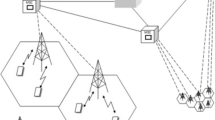Abstract
This paper proposes a Prioritized New Call Threshold Policy for Call Admission Control schemes. It is known that connection reattempts negatively affect the system performance. In currently proposed policy, the system’s performance is improved by decreasing the number of connection reattempts. In order to demonstrate that the proposed scheme is better than the traditionally utilized ones in terms of various parameters, the simulations were utilized. It predicts the time that the mobile station will spend in the current cell, mobile station with different remaining time will have different number of channels available for them. More channels are available for the new calls with higher remaining time. Simulations were used in order to show that the proposed scheme outperforms the traditionally employed mechanisms in terms of various parameters.







Similar content being viewed by others
References
Abdulova, V., & Aybay, I. (2011). Predictive mobile-oriented channel reservation schemes in wireless cellular networks. Wireless Networks, 17(1), 149–166.
Abdulova, V., & Aybay, I. (2014). Performance evaluation of non-prioritized and prioritized call admission control schemes in wireless cellular networks. Wireless Personal Communications, 78(1), 69–84.
Hong, D., & Rappaport, S. S. (1989). Priority oriented channel access for cellular systems serving vehicular and portable radio telephones. IEE Proceedings I (Communications, Speech and Vision), 136(5), 339–346.
Abdulova, V., & Aybay, I. (2011). A prioritized new call queuing policy for multimedia wireless cellular networks. Journal of Internet Technology, 12(3), 491–502.
Tran-Gia, P., & Mandje, M. (1997). Modeling of customer retrial phenomenon. IEEE Journal on Selected Areas in Communications, 15(8), 1406–1414.
Shingawa, N., Kobayashi, T., Nakano, K., & Sengoku, M. (2000). Teletraffic characteristics in prioritized hand-off control method considering reattempted calls. IEICE Transactions on Communications, 83(8), 1810–1818.
Marsan, M. A. (2000). An approximate model for the computation of blocking probabilities in cellular networks with repeated calls. Telecommunication Systems, 15(1–2), 53–62.
Gimenez-Guzman, J. M., Domenech-Benlloch, J., Pla, V., Casares-Giner, V., & Martinez-Bauset, J. (2007). Analysis of a cellular network with user redials and automatic handover retrials. Lecture Notes in Computer Science, 4712, 210–222.
Wang, J., Zeng, Q.-A., & Agrawal, D. P. (2003). Performance analysis of a preemptive and priority reservation handoff scheme for integrated service-based wireless mobile networks. IEEE Transactions on Mobile Computing, 2, 65–75.
Tekinay, S., & Jabbari, B. (1991). Handover and channel assignment in mobile cellular networks. IEEE Communications Magazine, 29(11), 42–46.
Katzela, I., & Naghshineh, M. (1996). Channel assignment schemes for cellular mobile telecommunication systems: A comprehensive survey. IEEE Personal Communications, 3(3), 10–31.
Fang, Y., & Zhang, Y. (2002). Call admission control schemes and performance analysis in wireless mobile networks. IEEE Transactions on Vehicular Technology, 51(2), 371–382.
Ahmed, M. H. (2005). Call admission control in wireless networks: A comprehensive survey. IEEE communications Surveys and Tutorials, 7(1–4), 50–69.
Martinez-Bauset, J., Gimenez-Guzman, J. M., & Pla, V. (2012). Robustness of optimal channel reservation using handover prediction in multiservice wireless networks. Wireless Networks, 18(6), 621–633.
Pati, H. K. (2013). A control-period-based distributed adaptive guard channel reservation scheme for cellular networks. Wireless Networks, 19(7), 1–15.
Ahmad, I., & Habibi, D. (2013). Improving quality of service in WiMAX communication at vehicular speeds: A new call admission control solution. Wireless Communications and Mobile Computing, 13(5), 451–459.
Tsiropoulos, G. I., Stratogiannis, D. G., Chen, H. H., & Cottis, P. G. (2014). Utility-based probabilistic call admission control for complete fairness in wireless networks. International Journal of Communication Systems, 27(3), 521–528.
GPSS World Simulation Package: http://www.minutemansoftware.com/simulation.htm. Accessed 23 April 2015.
Author information
Authors and Affiliations
Corresponding author
Rights and permissions
About this article
Cite this article
Abdulova, V., Aybay, I. Prioritized New Call Threshold Policy for Wireless Cellular Networks. Wireless Pers Commun 85, 2549–2563 (2015). https://doi.org/10.1007/s11277-015-2919-8
Published:
Issue Date:
DOI: https://doi.org/10.1007/s11277-015-2919-8




